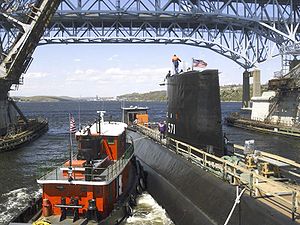
Back USS Nautilus AF غواصة يو أس أس نوتيلوس Arabic USS Nautilus (SSN-571) AZ USS Nautilus (SSN-571) BE-X-OLD USS Nautilus (SSN-571) BS USS Nautilus (SSN-571) Czech USS Nautilus (SSN-571) Danish USS Nautilus (SSN-571) German USS Nautilus (SSN-571) Greek USS Nautilus (SSN-571) EO
 The retired USS Nautilus heads home on 8 May 2002, after preservation by the Electric Boat Division
| |
| Class overview | |
|---|---|
| Builders | General Dynamics |
| Operators | |
| Preceded by | Tang class |
| Succeeded by | USS Seawolf |
| Built | 1952 |
| In commission | 1954–1980 |
| History | |
| Name | Nautilus |
| Namesake | Jules Verne's "Nautilus" submarine[1] |
| Awarded | 2 August 1951 |
| Builder | General Dynamics |
| Laid down | 14 June 1952 |
| Launched | 21 January 1954 |
| Sponsored by | Mamie Eisenhower (First Lady of the United States) |
| Completed | 22 April 1955 |
| Commissioned | 30 September 1954 |
| Decommissioned | 3 March 1980 |
| Stricken | 3 March 1980 |
| Status | Museum ship |
| General characteristics | |
| Type | Nuclear submarine |
| Displacement | |
| Length | 320 ft (97.5 m) |
| Beam | 28 ft (8.5 m) |
| Draft | 26 ft (7.9 m) |
| Installed power | 13,400 hp (10,000 kW)[3] |
| Propulsion | STR nuclear reactor (later redesignated S2W), geared steam turbines, two shafts |
| Speed | 23 kn (43 km/h; 26 mph)[4] |
| Complement | 13 officers, 92 enlisted |
| Armament | 6 torpedo tubes |
U.S.S. Nautilus (Nuclear Submarine) | |
 USS Nautilus docked at the Submarine Force Library and Museum | |
| Location | Groton, Connecticut |
| Built | 1952-1955, (commissioned 1954) |
| Architect | General Dynamics Corporation |
| NRHP reference No. | 79002653 |
| Significant dates | |
| Added to NRHP | 16 May 1979[5] |
| Designated NHL | 20 May 1982[6] |
USS Nautilus (SSN-571) was the world's first operational nuclear-powered submarine and on 3 August 1958 became the first submarine to complete a submerged transit of the North Pole. Her initial commanding officer was Eugene "Dennis" Wilkinson, a widely respected naval officer who set the stage for many of the protocols of today's Nuclear Navy of the US, and who had a storied career during military service and afterwards.[7]
Sharing a name with Captain Nemo's fictional submarine in Jules Verne's classic 1870 science fiction novel Twenty Thousand Leagues Under the Seas[8] and the USS Nautilus (SS-168) that served with distinction in World War II,[9] the new nuclear-powered Nautilus was authorized in 1951. Construction began in 1952, and the boat was launched in January 1954, sponsored by Mamie Eisenhower, First Lady of the United States, wife of 34th President Dwight D. Eisenhower; it was commissioned the following September into the United States Navy. Nautilus was delivered to the Navy in 1955.
Because her nuclear propulsion allowed her to remain submerged far longer than diesel-electric submarines, she broke many records in her first years of operation and traveled to locations previously beyond the limits of submarines. In operation, she revealed a number of limitations in her design and construction. This information was used to improve subsequent submarines.
Nautilus was decommissioned in 1980 and designated a National Historic Landmark in 1982. The submarine has been preserved as a museum ship at the Submarine Force Library and Museum in Groton, Connecticut, where the vessel receives around 250,000 visitors per year.
- ^ "Nautilus IV (SSN-571)".
- ^ Cite error: The named reference
DANFSwas invoked but never defined (see the help page). - ^ Polmar, Norman; Moore, Kenneth J. Cold War submarines: the design and construction of US and Soviet submarines. Brassey's.
- ^ Christley, Jim; Bryan, Tony. US Nuclear Submarines: The Fast Attack. Osprey.
- ^ "National Register Information System". National Register of Historic Places. National Park Service. 23 January 2007.
- ^ "Nautilus (Nuclear Submarine)". National Historic Landmark summary listing. National Park Service. Retrieved 3 October 2007.
- ^ Winters, Ann (28 March 2017). "Underway on Nuclear Power" -- The Man Behind the Words: Eugene P. "Dennis" Wilkinson, Vice Admiral USN. The American Nuclear Society.
- ^ Verne, Jules. 20,000 Leagues Under the Seas. Translated by Frederick Paul Walter – via Wikisource.
- ^ "Nautilus III (SS-168)". NHHC. Retrieved 17 January 2021.
